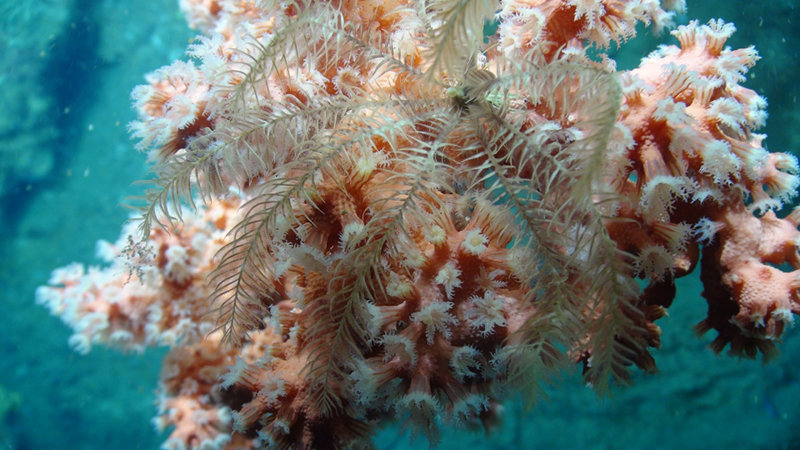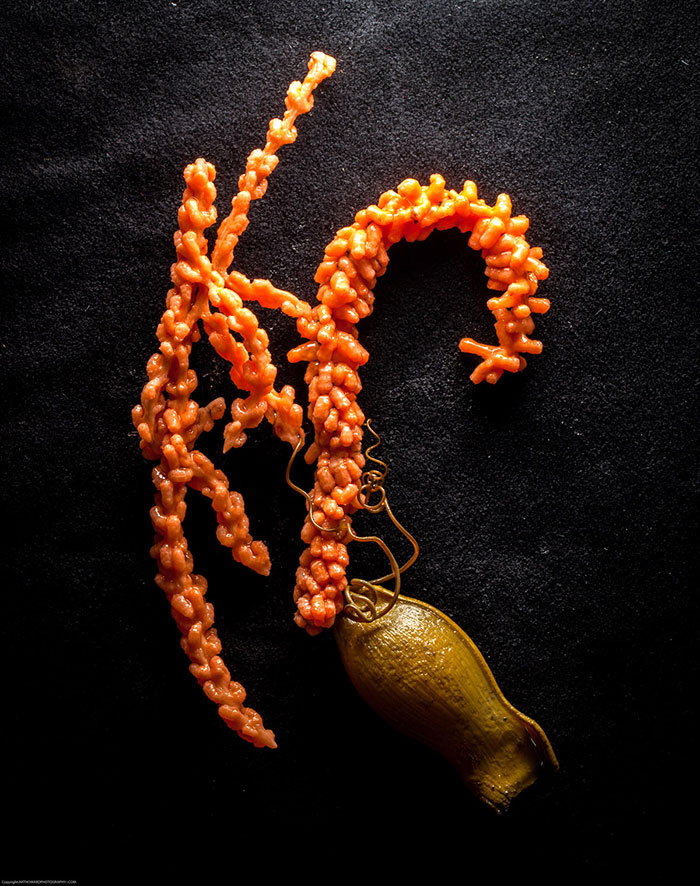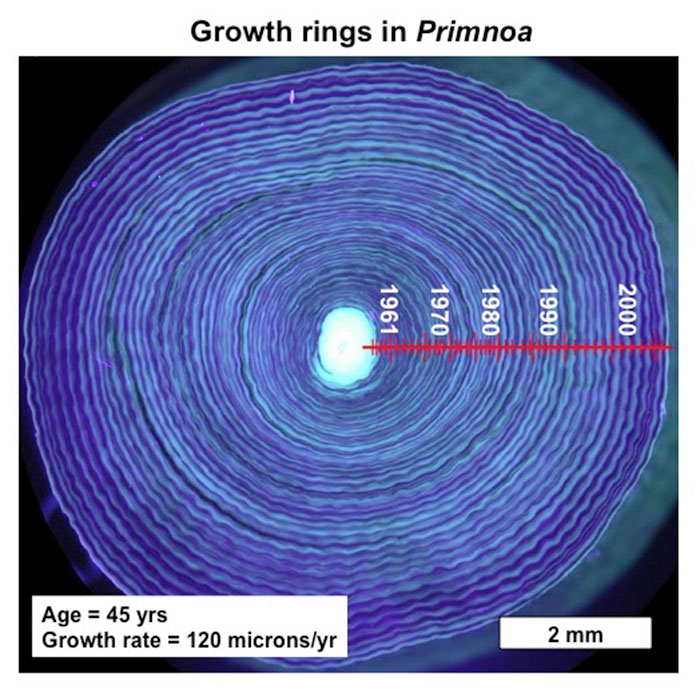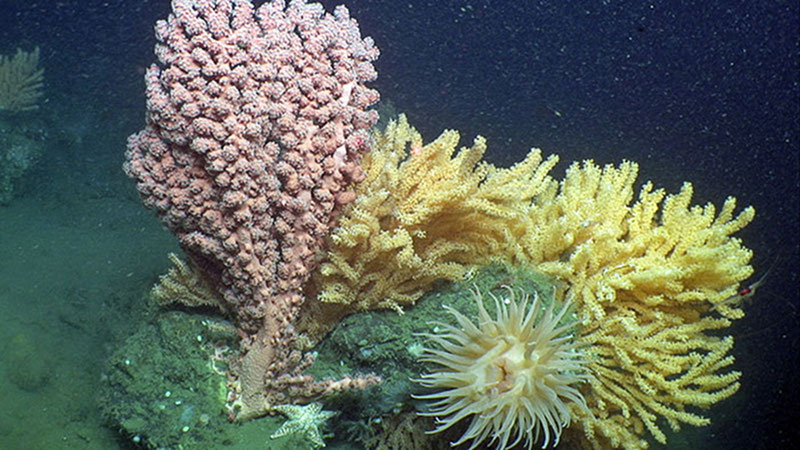
By Cheryl Morrison, Research Geneticist - U.S. Geological Survey
Nancy Prouty, Research Oceanographer - U.S. Geological Survey
Brendan Roark, Assistant Professor - Texas A&M University
May 11, 2013

Close-up of a crinoid attached to bubblegum coral (Paragorgia). The coral’s polyps are extended in feeding position. Both animals capture small organisms and organic matter in the water column as it drifts by. Image courtesy of Deepwater Canyons 2013 - Pathways to the Abyss, NOAA-OER/BOEM/USGS. Download larger version (jpg, 700 KB).
Two octocoral (sea fan) species we see often in the mid-Atlantic canyons are Paragorgia arborea (a.k.a. bubblegum coral) and Primnoa resedaeformis (red tree coral). These species are some of the largest and most widely distributed of the deep-sea octocoral species. When they occur in high densities, they are often referred to as "coral gardens."
These gardens rival flower gardens in terms of color and beauty! Colonies of Primnoa have a bushy shape, can be up to a meter in height, and are orange in color. Paragorgia colonies are often larger (up to 3 meters tall), have a concave fan-shape, and range in color from red to salmon-pink to white.
Although it may not seem like it at first glance, there are many parallels between coral gardens like those we’re seeing in the canyons and terrestrial forests. The corals create habitat that is utilized by other organisms; they have slow growth rates that, in some cases, can be measured by counting rings in a cross-section of their skeletons; and they can live for hundreds of years!

Wet lab photograph of a Primnoa sample with a shark or skate egg case attached, collected in 2012. Image courtesy of Art Howard, Deepwater Canyons 2013 - Pathways to the Abyss, NOAA-OER/BOEM/USGS. Download larger version (jpg, 806 KB).
Like trees in the forest, corals are a foundation species, creating three-dimensional habitat that other organisms call home. In other words, these deep-sea corals are ecosystem engineers since they create the structure that an entire ecosystem relies upon, therefore concentrating and enhancing biodiversity.
We see brittle starfish of many types; crustaceans such as shrimps, copepods, amphipods, ostracods and barnacles; anemones; and polychaete worms, just to name a few. Fishes are also attracted to the habitat created by deep-sea corals, and in some cases, fishes rely on the corals for part of their reproductive cycle. For example, catsharks commonly lay egg cases on the branches of Paragorgia and other octocorals.
Large forest trees are hundreds of years old. We know this because we can count annual growth rings in cross-sections of tree trunks. Deep-sea corals can also be hundreds of years old. In fact, some coral species can be as old as the oldest known trees, the bristlecone pines. For example, a black coral species, Leiopathes, has been aged at over 4,000 years, making them the longest-lived marine organism known.

Ultraviolet light illuminates the growth rings in a cross section of a 44-year-old deep-sea coral (Primnoa resedaeformis) collected of the coast of Newfoundland at 400 meters (Sherwood et al., 2005). Similar to trees, this cross section reveals coral-growth rings that can be counted to determine the age of the coral. Image courtesy of Owen Sherwood. Download image (jpg, 123 KB).
The Primnoa coral we’ve collected during this cruise will be aged by two of our scientists, Brendan Roark (Texas A&M) and Nancy Prouty (USGS), who are experts in aging techniques.
The skeletons of Primnoa have growth rings that appear to be approximately annual, reflecting fluctuations in food supply. Estimated linear growth rates for Primnoa range from 1.5 to 2.5 millimeters per year, but growth is likely slower when the corals are young and old. Paragorgia, on the other hand, has a less dense skeleton that does not have reliable growth rings. Instead, estimates of ages have been obtained by photographing the same individual twice, the second photo a year later, then comparing the length of branches on the overlaid digital images, as well as detecting the presence of bomb produced radiocarbon (carbon-14) over the last ~50 years.
Both corals and trees spend their lives in one place. Where they settle down when young is where they will remain for life. Opportunity to move comes very early in life for both of these types of organisms. In most tree species, the creation of new individuals involves the production of flowers by females, followed by pollination, fruit and seed development, then finally dispersal to new locations that may be assisted by animals that eat seeds then move, or wind dispersal.
Although much less is known about the reproductive process in corals, many octocorals spawn gametes into the water column, where they meet, fertilize, and become larvae that either drift in currents or swim to some degree. Although these larvae may have the potential to follow currents and travel large distances (hundreds of kilometers), genetic studies of shallow water corals have demonstrated that many larvae don’t travel very far from their parents.

Red bubblegum coral (Paragorgia) and several colonies of Primnoaoccupy a boulder in close proximity to an anemone and sea star, at ~440 meters in Norfolk Canyon. Image courtesy of Deepwater Canyons 2013 - Pathways to the Abyss, NOAA-OER/BOEM/USGS. Download larger version (jpg, 1.2 MB).
We will try to gauge how far larvae of Paragorgia and Primnoa travel using genetic techniques that quantify how unique populations are. The more connected populations are via exchange of larvae, the more similar their genetic profiles will be. We hypothesize that populations within one canyon will be more similar to each other than populations between Norfolk and Baltimore canyons.
Unfortunately, like forests, these life history traits also make the coral gardens especially vulnerable to destruction. The long life spans and slow growth rates shared by both trees and deep-sea octocorals suggests that regeneration of these habitats could take decades or centuries. In other words, destroyed habitat may not be replenished in our lifetimes.
Given all of the unknowns about the factors that influence reproductive success and failure for deep-sea octocoral species, it is very difficult to predict how this process may play out, and whether techniques used to help regenerate forests, such as artificial propagation, may also work for deep coral ecosystems. Some of the pieces of the puzzle involving the life histories of Paragorgia and Primnoa may be solved through this research, and may help us understand and protect these complex ecosystems.